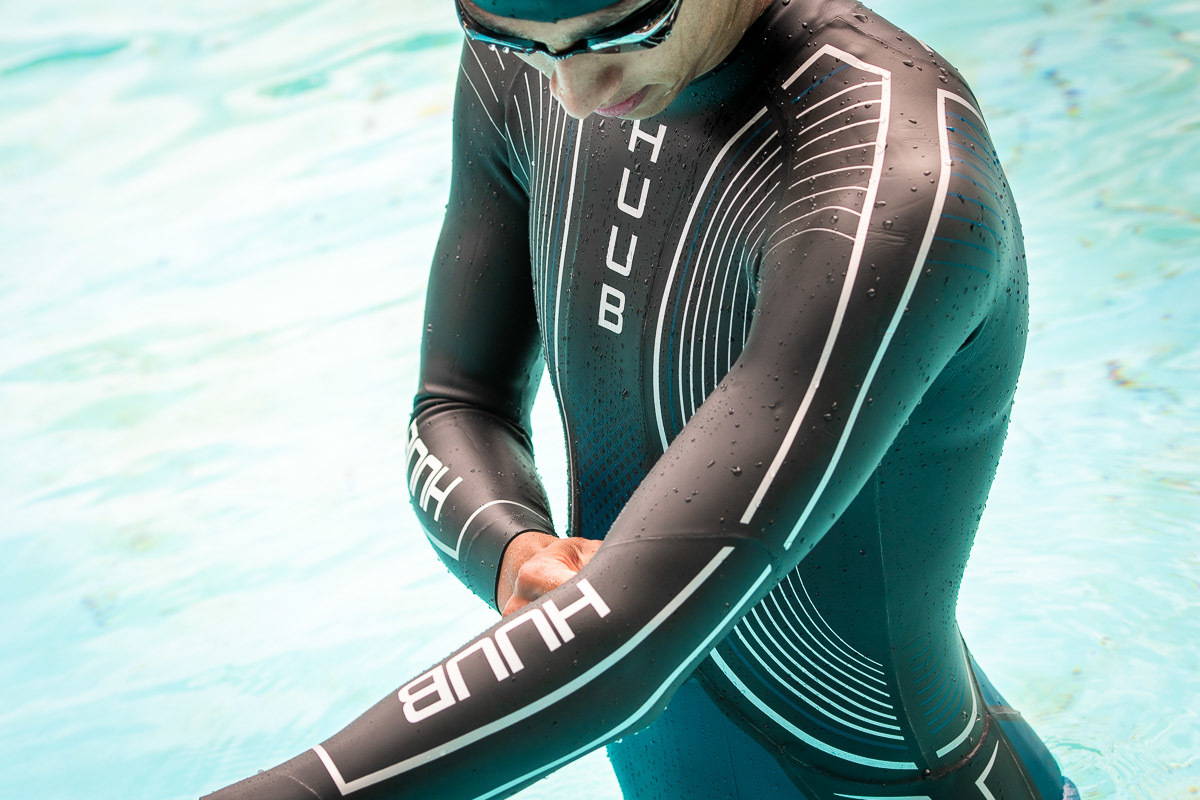Schwimmen ohne Neo? Für viele eine unangenehme Vorstellung - so wertvoll ist er doch für die Verbesserung der Wasserlage und eine deutlich effizientere Schwimmtechnik. Wir erklären was hinter der Technologie der schnellen Schwimmhäute steckt.
REGELWERK
Die Bestimmungen zu Nutzung eines Neoprenanzugs im Triathlon finden sich in §§20+21 der Sportordnung der DTU wieder. Hier geht es vor allem um die Eigenschaften eines Kälteschutzanzugs (was ist erlaubt/was ist verboten). Angenehmer Nebeneffekt des Kälteschutzes ist allerdings ein erheblich verbesserter Auftrieb und niedrigere Reibungswerte beim Gleiten durch das nasse Element.
Hinter dem Markennamen „Neopren“ der Firma DuPont versteckt sich Chloropren-Kautschuk. Im Jahr 1932 brachte diese US-amerikanische Firma das Polymer als erstes unter dem damaligen Namen Duprene auf den Markt. Das Material hat kälte-isolierende Eigenschaften und schützt damit Triathleten vor Auskühlung im Wasser.
Im Triathlonregelwerk ist der Neoprenanzug zwar als Kälteschutzanzug geführt, allerdings achten die Hersteller der Neoprenanzüge besonders darauf, dass ihre triathlonspezifischen Anzüge nicht als Kälteschutz bezeichnet werden. Der Grund: Für „Kälteschutzanzüge“ gelten besondere Regeln, da sie eine CE-Norm erfüllen müssen und das wiederum würde höhere Kosten verursachen.
MATERIALSTÄRKE
Der Welttriathlonverband (ITU) erlaubt den Einsatz von Neoprenstärken bis maximal fünf Millimetern.
Grundsätztlich gilt: je dicker das Neopren, umso mehr Auftrieb und Kälteschutzwirkung ist vorhanden, ABER umso weniger dehnfähig und elastisch ist in der Regel das Material.
Bei den meisten Neoprenanzüge kommen daher verschiedene Materialstärken zum Einsatz, da sie aus verschiedenen Einzelelementen zusammengesetzt (vernäht/verklebt) sind. Überall dort, wo gute Auftriebseigenschaften gefragt sind, findet sich dickeres Material wieder: zumeist im Bereich der Hüfte und Oberschenkel. In den auftriebstärksten Modellen kommt zusätzlich die "Aerodome-Technologie" zum Einsatz. Kleine Luftzellen im Material erhöhen den Auftriebseffekt in diesen Bereichen noch einmal zusätzlich (gut erkennbar an der Wabenstruktur). An Stellen starker Dehnbelastungen sorgt tendenziell dünneres Material (oftmals 1 bis 2 Millimeter) für höhere Flexibilität. Das ist vor allem im Bereich der Arme und Schultern wichtig.
MATERIALQUALITÄT
Weltweit gibt es eine handvoll Unternehmen, die aus synthetischen Kautschuk das geeignete Material für die Herstellung von Triathlonneoprenanzügen fertigen kann. Bekanntester Fabrikant ist Yamamoto, dessen Material in den meisten höherwertigen Anzügen zum Einsatz kommt. Dabei gibt die Nummerierung Aufschluss über die Eigenschaften. Je höher die Ziffer, umso weicher und elastischer ist das Material. Das aktuell flexibelste Material ist Yamamoto #45.
Der Unterschied zwischen den Neoprensorten liegt in der Anzahl der eingeschlossenen Nitrogenbläschen, die durch das Aufschäumen des synthetischen Kautschuks entstehen. Durch die isolierende Wirkung der Nitrogeneinschlüsse entsteht einerseits der Kälteschutz des Anzuges, andererseits auch der Auftrieb im Wasser. Je mehr Gaseinschlüsse pro Raumeinheit, desto dehnfähiger und flexibler ist Neoprenmaterial.
Nachteil solcher Hi-Tec Materialien ist die niedrigere Resistenz gegen mechanische Einflüsse. Aus diesem Grund wird der geschäumte Kautschuk mit Nylongewebe laminiert - das ist das Innengewebe des Neoprenanzugs. Dabei gilt es zu beachten, dass erst das Laminat aus Kautschuk und Textilgewebe für die Flexibilität des Triathlonneoprenanzuges verantwortlich ist. Wenn also das innenliegende Textilgewebe nicht ebenso dehnfähig ist, ist das flexibelste Neoprenmaterial nutzlos.
OBERFLÄCHE
Anfang der neunziger Jahre führte Yamamoto die SCS – Technologie (Super Composite Skin – Beschichtung) ein. Diese spezielle Beschichtung verringert die Reibungswiderstände der Neoprenoberfläche.
Mittlerweile ist die Nano SCS Beschichtung state-of-the-art. Dabei Handelt es sich um eine Weiterentwicklung der Yamamoto Erfindung bei der Nano Partikel auf der Neoprenoberfläche den Wasserwiderstand noch weiter verringern.
FARBE
Grundsätzlich ist die Grundfarbe eines Neoprenanzuges schwarz, wofür die Färbung des synthetischen Kautschuks verantwortlich ist. Bei der Produktion besteht die Möglichkeit, Farbstoffe beizumengen. Dabei wird jedoch auch die Dehnfähigkeit des Neoprens herabgesetzt. Bei vielen Herstellern kommt die Farb-Beimengung aus Marketinggründen trotzdem zum Einsatz. Eine weitere Möglichkeit den Neopren einzufärben ist das Aufdrucken von Farbe auf den Anzug. Dieses Verfahren findet beim Aufbringen der Logos seinen Einsatz.
ZUSATZEIGENSCHAFTEN
Viele Hersteller versehen ihre Neoprenmodelle mit zusätzlichen Materialeigenschaften, um sie noch gezielter für bestimmte Aspekte der Wasserlage oder des Schwimmverhaltens zu optimieren. Zum Beispiel: sogenannte "Roll Bars" oder "Stability Panels" sind Verstärkungen meist im Rumpf- oder Hüftbereich, die eine Überrotation verhindern und damit die Wasserlage zusätzlich stabilisieren sollen. "Forarm Panels" hingegen sind Strukturelemente an den Unterarmen einiger Neoprenmodelle mit dem Zweck, das "Wasserfassen" und den Armzug zu verbessern. Je nach Ausgestaltung und Zielgruppe des Neoprenanzugs kommen hier verschiedene solcher Zusatzeigenschaften zum Einsatz. Die Bezeichnungen für diese Elemente variieren jedoch zumeist von Hersteller zu Hersteller, da Design und Verarbeitung oftmals patentrechtlich geschützt sind.
DIE ZWEITE HAUT
Das Zusammenspiel aller Eigenschaften macht den Neoprenanzug zu dem, was er ist: Kälteschutz, Schwimmhilfe, zweite Haut. Da jeder Sportler über unterschiedliche Voraussetzungen verfügt (z.B. Wasserlage, Schwimmfähigkeiten) und unterschiedliche Ziele verfolgt (Häufigkeit der Wettkämpfe & Schwimmdistanz), sind die Neoprenanzüge für verschiedene Zielgruppen konzipiert: Anfänger oder Fortgeschrittene? Gute oder schlechte Wasserlage? Viel oder wenig Auftrieb? Für kurze oder längere Schwimmdistanzen?
WELCHER NEO IST DER RICHTIGE?
Finde es heraus beim Neotest:




















